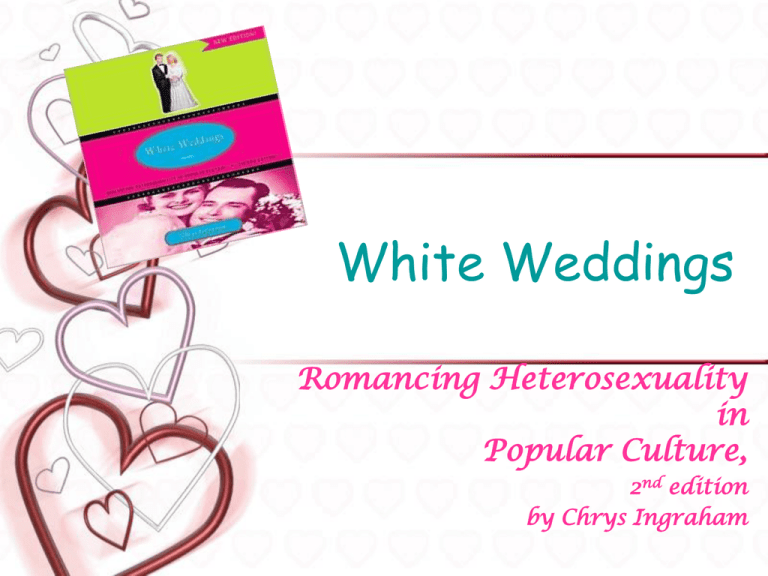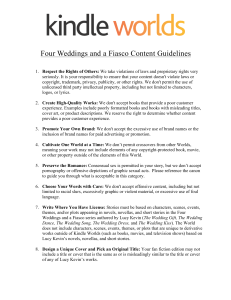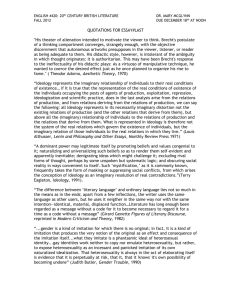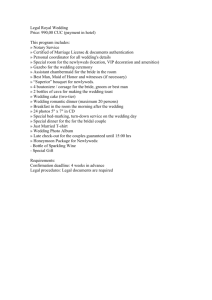White Weddings
advertisement

White Weddings Romancing Heterosexuality in Popular Culture, 2nd edition by Chrys Ingraham Chapter 3: Romancing the Clone: The White Wedding “Match a pretty girl with a handsome guy. It’s true love, now don’t be shy. Dress them in a tux and a wedding gown…. They’re the happiest couple in town! Next a chapel wedding for the bride and groom, then send them off on their honeymoon. Now move them into their family home… add special stickers to make it their own! The time has come for a sweet surprise… a dear little baby with love in her eyes! Inside! A baby for you after saying ‘I do!’.” Family Corners toy by Mattel “People who are ugly are not worthy of a wedding!” --the wedding singer in the film The Wedding Singer Romancing the Clone: The White Wedding • Romancing heterosexuality in a manner such as that of the Family Corners toy— images common to a wide variety of children’s toys—ensures an ongoing wedding market that also preserves patriarchal authority, racial separation, and a heterogendered view of the world. • These images perpetuate the myth that housework and family are the exclusive domain of women and they keep in place an expectation that women must be dependent on men for the survival of the family. Romancing the Clone: The White Wedding • One of the key organizing principles of the wedding market: All brides are beautiful! Estée Lauder has long used an advertising campaign for its perfume depicting a white, blond flower girl in a white dress looking up into the eyes of a white, blond bride in a white wedding gown. The only text in the ad says “Beautiful,” establishing the white bride and the future bride as standardbearers of what counts as beauty. • What’s not said but is implied in bridal magazines, children’s toys, popular film, television, and advertising is that something is wrong with people who do not marry. • The sites establish what counts as beautiful in mainstream American popular culture—a woman who is white, fair, thin, and female. Romancing the Clone: Consequences • For anyone who doesn’t meet these standards the effects can be moderate to severe, manifesting in everything from eating disorders to the toleration of domestic violence to labor abuses. • These messages perpetuate gender, racial, class, and sexuality hierarchies, setting up some groups to fare poorly in relation to dominant constructions of heterosexuality. The Institution of Heterosexuality • The institution of heterosexuality as it is currently organized functions as a form of social control and depends upon the heterosexual imaginary to conceal its regulatory function and effects. • Women are taught from early childhood to plan for “the happiest day of their lives.” (Apparently, everything after that is down hill!) Men are taught, by the absence of these socializing mechanisms, that their work is “other” than that. • Gender is the central organizing concept for the institution of heterosexuality, setting the standards for male/female relations at all levels—more accurately called heterogender. The Wedding Ideological Complex and Messages Bridal magazines Wedding books Religion Etiquette Brides are beautiful. Business Here comes the bride, all dressed in white…. Wedding industry Your wedding is the most important day of your life. It’s your special day! Music Celebrity weddings The Arts It’s the perfect ending to your fairy tale romance! Popular culture New media Newspaper Wedding Pages Theme parks Toys World Wide Web It will be your dream come true! You’ve been planning this your whole life! Children’s television and films Perfect, perfect, perfect…everything must be perfect! Wedding-Ideological Complex • In order for the wedding industry to be “recession-proof”—that is, that people will pay for a wedding no matter what—it must rely on a very powerful meaning-making apparatus guaranteeing our compliance and consent to participate. • This wedding-ideological complex is made up of those sites in American popular culture— children’s toys, wedding announcements, advertising, film, internet, television, bridal magazines, jokes, cartoons, music—that work as an ensemble in creating many taken-forgranted beliefs, values, and assumptions within social texts and practices about weddings. Wedding-Ideological Complex • One of the central functions of this complex is to create the conditions that allow us to imagine possibilities in relation to weddings, marriage, heterogender, race, class, and heterosexuality. • The beliefs we hold about weddings and marriage emanate from a variety of historical and material sites and are made use of daily in the wedding market. • These meanings rely on romantic and sacred notions of heterosexuality (or a heterosexual social order) in order to create and maintain the illusion of wellbeing—the heterosexual imaginary. Wedding-Ideological Complex and Social Class Distribution of Wealth 2004 -1% 1% 11% 5% Top 20% 2nd 20% 3rd 20% 4th 20% 5th 20% 84% Distribution of Income 2004 10% 4% Top 20% 15% 48.1% 22.9% 2nd 20% 3rd 20% 4th 20% 5th 20% Wedding-Ideological Complex and Social Class • One of the dominant ideologies of capitalism, disseminated through a wide variety of institutions (e.g., education, law, media, family, science, medicine, government, and religion), is the belief that inequalities of wealth and income are socially just. • Competition, another central organizing principle of capitalism, combined with meaningmaking systems circulating in an array of social practices including weddings, sets the terms for consenting to the ruling order and to its mechanisms for distributing wealth unevenly. • This is the primary rationale for belief systems organizing heterosexuality, race, class, gender, and age. Wedding-Ideological Complex and Popular Culture • Popular culture justifies the dominant social order and binds us to it. • Popular culture, which is also mass culture and dominated by the mass media—television, film, magazines, newspapers, radio, and the internet— is controlled by the same owning class that controls the country’s wealth and income. Romance and the Wedding-Ideological Complex • One of the central organizing concepts of the wedding-ideological complex is the notion of romance or romantic love. • Romance is ideology in action. • Ideology manifests in words and images that establish and regulate meanings and beliefs justifying dominant interests. • Ideologies naturalize our socially created world, replacing realistic perceptions with idealized notions of that world. • Romance ideology works to secure in the popular imagination the notion that enthusiasm or the promise of love, lust, and passion are what constitutes real love. For example…. • Consider our national romance with engagement practices. • We perceive the promise to marry and the act of marrying (the wedding) as instances of love and commitment. • It isn’t until the real experience of living, loving, and caring for another that couples discover what love requires. The Ideology of Romantic Love • The ideology of romantic love is a belief in a social relation disconnected from real conditions of existence—a social relation that masks or conceals contradictions in favor of reproducing a reassuring illusion or the promise of well-being and bonding. • This ideal depends upon a belief in monogamous coupling as the preferred manifestation of love relationships, making all other possibilities unimaginable or unacceptable. The Ideology of Romantic Love • It elevates the individuals in the couple to the status of unique and exclusive, bestowed with the mantle of “chosen one” or “one and only” from “now until forever,” “’til death do us part.” • It is here that the ideology of romantic love incorporates property relations, naturalizing love with ownership, a pervasive belief about romance, commitment, and marriage. • The extension of these beliefs manifests in feelings of possessiveness, jealousy, and, in many cases, violence. Patriarchal Heterosexuality and the Ideology of Romantic Love • Patriarchal heterosexuality makes use of the ideology of romantic love to serve the interests of male dominance and capitalism. • It reinforces a heterogendered division of labor that subordinates women’s needs to men’s desires, notions that are central to the heterosexual imaginary. • Creating the illusion of plenitude and fullness, the ideology of romance produces a belief that sexual objectification and subordination are both natural and justified. Patriarchal Heterosexuality and the Ideology of Romantic Love • In the film The Birdcage, the senator’s wife recommends a high-status wedding for their daughter as a way to cleanse away the shame of a political scandal. She exclaims, “What about a wedding? A big white wedding! Why not? It would restore your image. A wedding is hope, a white wedding is family and morality and tradition and it would be such a special marriage... and to a cultural attaché’s son. It would be love and optimism versus cynicism and sex!! It would be an affirmation!” • This example reflects the success of the weddingideological complex in guaranteeing future markets and preserving ruling-class interests by securing in the collective consciousness the association of weddings with whiteness and wealth, morality and optimism. Patriarchal Heterosexuality and the Ideology of Romantic Love • Whiteness, wealth, and weddings become central features of the ideology of romantic love, communicating a sign system that collapses them into one package. • The way the heterosexual imaginary works is by making use of both fantasy and nostalgia. The effect is a masking of the very real, contradictory, and complicated ways institutionalized heterosexuality works in the interests of the dominant classes. • Through the use of nostalgia, romance renarrates history and naturalizes tradition. Patriarchal Heterosexuality, the Ideology of Romantic Love and the Ideal of Femininity • The cultural codes of traditional femininity permeate bridal culture, from Barbie and other wedding toys to messages in bridal advertising, even though marketers are aware that they are catering to women who occupy positions of privilege and power. • The ideal of femininity reproduced in bridal culture reflects middle-class standards for “appropriate” heterogendered behavior, resecuring women’s role as subordinate to men. • The images of femininity and whiteness that so pervade popular cultural wedding sites serve to secure in the collective imagination the place of women from particular classes and racial groups. The Spectacle of Accumulation • Bridal magazines make it their business to prepare the bride for her part in “the most important day of her life” and for planning “her day.” • By producing and exploiting the bride’s welldeveloped and well-orchestrated fantasy of the “perfect” wedding with her as the “perfect” bride with the “perfect” romance, the wedding industry is able to promote accumulation. • Real wedding stories about princesses and celebrities support advertisers’ efforts to reach their audience, secure the economic health of bridal magazines, and ensure that the consumption-based wedding market imagines itself emulating royalty and wealth. The Spectacle of Accumulation • The spectacle of wealth is never called into question but instead becomes integrated into the romantic illusion. • The heterosexual imaginary collapses the romantic and the material world together in the creation of the wedding spectacle. • The spectacle—especially the media or celebrity spectacle—works ideologically, conveying to the observer/reader what they should believe about romance, weddings, marriage, and heterosexuality. The Power of the Heterosexual Imaginary • The power of the heterosexual imaginary circulating in in popular culture begins by naturalizing gender as though it is somehow related to our biology and not the result of social processes or organized in the interests of institutionalized heterosexuality. • Obscured from view are the powerful ruling interests being served by the institution of heterosexuality. • Weddings, marriage, romance, and heterosexuality become naturalized to the point where we consent to the belief that marriage is necessary to achieve a sense of well-being, belonging, passion, morality, and love. • We live with the illusion that marriage is somehow linked to the natural order of the universe rather than see it as it is: a social and cultural practice produced to serve particular interests. The Power of the Heterosexual Imaginary • By allowing the heterosexual imaginary to circulate freely with our consent and without question, we participate in the production and perpetuation of racial, class, gender, and sexual hierarchies; legitimize ruling interests; and fail to provide our children with the imaginations and skills they need to become critical citizens of the world. • The institution of heterosexuality as it is currently organized serves the interests of capitalist patriarchy, functions as a form of social control, and depends upon the heterosexual imaginary to conceal its regulatory function and effects. • Paradoxically, the heterosexual imaginary applies to all relationships, not just those between men and women. It is about belief systems not bodies.





